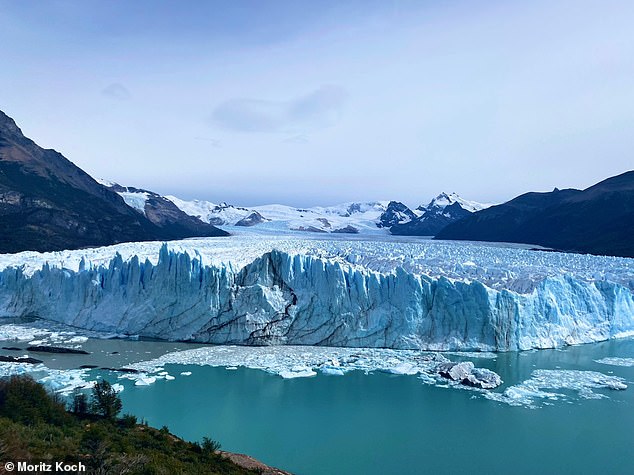It’s been described as one of the most stable glaciers on the planet.
But the 18-mile-long Perito Moreno glacier in Argentina is on the verge of total collapse due to climate change.
German scientists reveal that it is quickly getting both thinner and shorter – leading to an alarming reduction in its overall mass.
And it could soon disappear altogether within our lifetime, possibly a matter of decades from now.
Study author Moritz Koch, a PhD student at Friedrich-Alexander University of Erlangen-Nuremberg, said climate change has ‘already destroyed one of the most spectacular natural phenomena on Earth’.
‘Climate change, especially warmer temperatures have triggered the evolution we can observe today,’ he told the Daily Mail.
Glaciers are slow-moving rivers of ice – some hundreds of thousands of years old – that reflect the sun’s rays back into space and store valuable freshwater.
If they all completely melted, global sea levels would suddenly rise, flooding cities, displacing millions of people and destroying infrastructure.

Scientists report a rapid decline of the Perito Moreno glacier, which until now was considered stable Pictured, the glacier’s terminus as seen from a visitor point on the Península de Magallanes, April 2022

Pictured, a view of a heavily ‘crevassed’ area of the glacier with deep cracks and fissures, taken during a survey flight in April 2022

Satellite imagery reveals the retreating Perito Moreno glacier between March 2020 and March 2025
Declared a UNESCO World Heritage Site in 1981, Perito Moreno is a major Argentinian tourist destination due to its size and accessibility.
It has has ‘long been considered stable despite widespread regional glacier retreat’, according to Koch and colleagues.
To assess its ‘current state and future fate’, the team analysed satellite data and surveyed the glacier using a special radar system hung from a helicopter.
The ground-penetrating radar apparatus, which looks like an oversized Meccano toy, can scan through the ice to work out its dimensions.
This resulted in a map of the previously unknown glacier bed and allowed the team to analyze the decades-long development of the ice masses.
According to the findings, from 2000 to 2019, Perito Moreno lost about 13.3 inches (34cm) of thickness per year, melting relatively slowly.
But after that, this shrinkage accelerated dramatically to about 16 times the previous rate, reaching 18ft to 21ft (5.5 to 6.5 metres) per year from 2019 to 2024.

The helicopter-borne radar antenna system flying over the Brazo Upsala arm of Lago Argentino, where the neighbouring Upsala glacier terminates, during field work conducted in 2024

The team with their ground-penetrating radar apparatus, which looks like an oversized Meccano toy and can scan through the ice to work out its dimensions

Pictured, the location of the Perito Moreno glacier in Argentina. Coloured lines in image C shows the location of the glacier ‘terminus’ over recent years
Every 12 months, the ice thickness decreased by the height of a house. But Perito Moreno is not only getting thinner, it is also getting shorter.
In some areas the glacier had retreated by more than 2,600 feet (800 metres) since 2019.
‘It is also retreating (losing area), especially towards its northern margin, where we can observe a retreat of more than 800 metres,’ Koch told the Daily Mail.
‘The retreat rate of the glacier margin is quite heterogenous [not uniform] owing to the difference in lake depth.’
Results also revealed the presence of a large rocky ridge beneath the glacier’s terminus – which the glacier is currently grounded on – that may have been responsible for its stability before 2019.
The authors caution that if the glacier’s current thinning rate persists, it will detach from the rocky ridge and rapidly retreat even more, although it is not yet clear when this might happen.
At the moment, the glacier divides Lago Argentino, the largest freshwater lake in the entire country.
But as the ice cover becomes thinner and lighter, the water of Lago Argentino gives the glacier more buoyancy. This buoyancy causes more ice to break off from the glacier terminus or ‘tongue’, further accelerating the retreat.

Glaciar Perito Moreno as seen from below Cerro Buenos Aires on the Península de Magallanes, October 2024

Perito Moreno in Argentina, often described as one of the most stable glaciers, is retreating far more rapidly than previously thought. Pictured, the ice front of the glacier’s terminus, as seen from the western-most point of the Península de Magallanes, October 2024

Glaciar Perito Moreno as seen from below Cerro Buenos Aires on the Península de Magallanes, October 2024
The study, published in the journal Nature Communications Earth and Environment, warns that the glacier ‘may well be on the verge of collapse’.
Perito Moreno may now be following a similar pattern of other retreating calving glaciers in Patagonia, the geographical region at the southern end of South America.
‘The glacier is undergoing its most substantial retreat in the past century as of the writing of this paper,’ the team conclude.
The study follows the creation of a ‘Global Glacier Casualty List‘, which documents glaciers that are soon to disappear, or have already melted away.
Its creators warn that over three-quarters of global glacier mass is expected to disappear under present climate policies.
This article was originally published by a www.dailymail.co.uk . Read the Original article here. .

